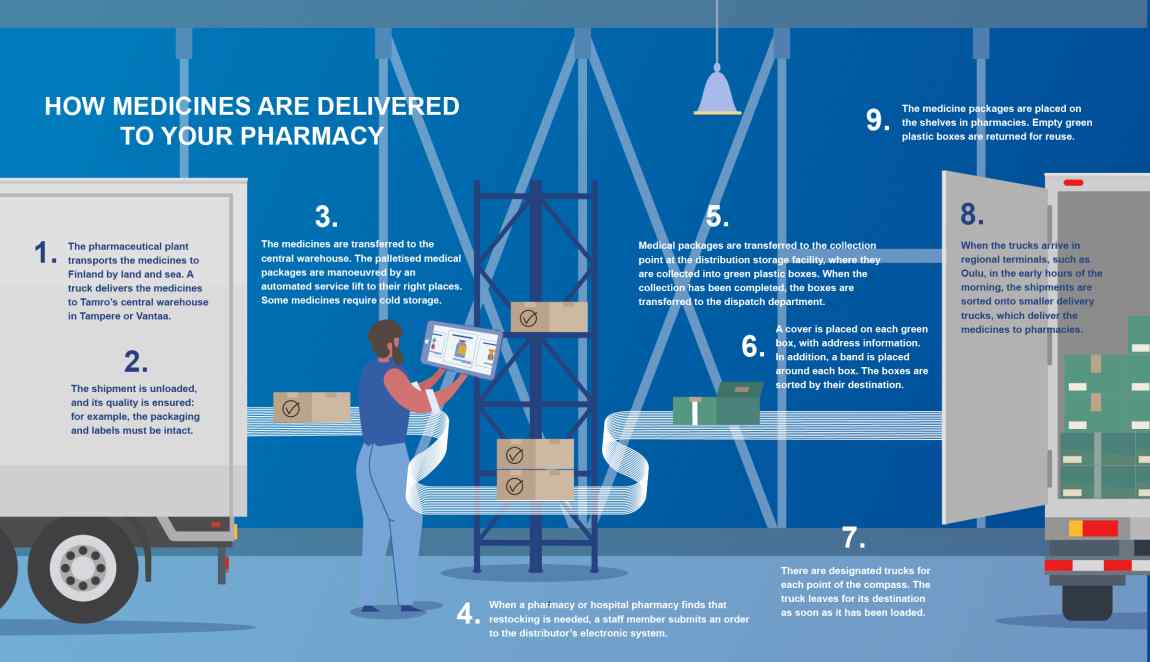
Pharmaceutical distribution is a carefully scheduled and planned operation. For example, the availability of medicines for intensive care must be ensured in all circumstances, which is why legions of trucks deliver medicines across the country every night, even to the remotest pharmacies and hospitals. Thanks to Tamro’s 24/7 on-call service, urgent orders for critical preparations from hospitals can be fulfilled whenever necessary.
A medicine has come a long way – strictly regulated and controlled – before a consumer can buy the medicine at a pharmacy or a healthcare professional can choose it to treat their patient. In cooperation with pharmaceutical manufacturers, Tamro’s pharmaceutical distribution ensures that each shelf at each pharmacy is filled with the products that the pharmacy has ordered. The multiphase chain between the pharmaceutical plant and the patient is extremely carefully planned and must not be broken.
In each phase, it’s checked multiple times that the right medicine is being dispatched to the right place and that there are no interruptions in the availability of medicines. Our job is to ensure that the properties and quality of the medicine remain safely unchanged during transport. For example, some medicines require an uninterrupted cold chain, says Anni Svala, Quality Director at Tamro.
The process is largely automated, but trained professionals closely monitor each step.
The distributor’s responsibility for medical shipments usually begins when the delivery from the pharmaceutical company arrives in our central warehouse and ends when the medicine has been delivered to the pharmacy, says Logistics Director Aki Koskinen.
The on-call service always answers
Despite the good preparedness of hospitals and pharmacies, urgent orders for medicines sometimes need to be placed. For example, all very rarely needed medicines cannot be kept in stock at hospital pharmacies at all times. Urgent orders can be placed through Tamro’s on-call service and delivered via taxi.
Urgent deliveries may be necessary at any time of the day. The on-call service answers at all times, and the necessary medicines are collected manually. The delivery is made using the fastest possible option, which is often a taxi.
In extreme cases, the patient is already in the operating theatre when a sudden need emerges for a medicine that is not available. All rare medicines cannot always be kept in stock in all healthcare locations. In such a case, someone from the operating theatre calls the hospital pharmacy, which contacts the pharmaceutical distributor’s on-call service. In cases of poisoning, for example, there may be a need for large quantities of medicines that are not kept continuously in stock.
To be able to fulfil such urgent and critical requests, our on-call service is available around the clock on every day of the year, says Quality Director Anni Svala.
When an emergency delivery request reaches Tamro, employees immediately begin to process the order and determine whether the product is available in the Vantaa or Tampere distribution warehouse. Then they contact the logistics centre in question, where the on-call employees are ready to collect and package the product and dispatch the delivery via taxi.
The medicine is usually on its way within an hour of the call from the pharmacy. The taxi ride takes its time, of course, but it’s the quickest way to deliver the medicine, says Aki Koskinen
CAPTIONS:
- Trucks carrying medicines arrive in Finland on a ferry via Sweden or Germany. The responsibility for the pharmaceutical products is usually transferred to the distributor – that is, Tamro – once the truck arrives in its central warehouse in Tampere or Vantaa.
- The delivery is unloaded and its quality is ensured: for example, the packaging and labels must be intact and correspond to the batch documents. At this point, it’s also checked that the delivery contains no counterfeits. The EU has a medicines verification system in place: the authenticity of a medicine can be checked throughout the supply chain based on its serial number.
- The palletised medicine packages are manoeuvred automatically in the high storage space at the central warehouse. If a medicine requires cold storage, it’s unloaded in a separate cold facility and placed into cold storage (2–8°C). The temperature is monitored continuously.
- The internal system transfers medicines from the central warehouse to the distribution storage facility: a full pallet or a smaller quantity of medicine packages is transferred to the collection point for customer collection. When a medical order from a pharmacy arrives in the electronic system, the collection of the products begins at the end of the afternoon, usually by 3 pm.
- Customer orders are collected into green plastic boxes. They are transferred on the line system automatically to the collection points, where the medicines are collected either manually or automatically. At this point, a large number of medical shipments are being transferred between workstations at the distribution storage facility. When the collection has been completed, the boxes are transferred to the dispatch department.
- A cover is placed on each green box, with address information. In addition, a band is placed around each box. The boxes are now ready for dispatch. The boxes are sorted by their destination at the dispatch department.
- There are designated trucks for each point of the compass: for example, medical orders to be delivered to northern Finland are loaded in their designated trucks. There are many types of medicines in the same truck, some of which are packaged in cold boxes in line with their condition requirements. The truck leaves for its destination as soon as it has been loaded.
- When the trucks arrive in regional terminals, such as Oulu, in the early hours of the morning, the shipments are sorted onto smaller delivery trucks, each of which has its own route. The last shipments will be delivered no later than in the afternoon of the same day.
- The medicine packages are placed on the shelves in pharmacies. The green plastic boxes will be reused, so empty boxes are returned to Tamro when the next shipment of medicines arrives.